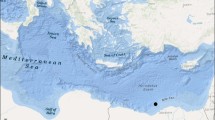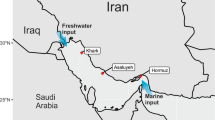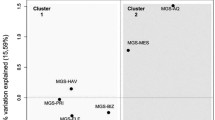Abstract
Ocean acidification may exacerbate the environmental impact of oil hydrocarbon pollution by disrupting the core composition of the superficial (0–1 cm) benthic bacterial communities. However, at the subsurface sediments (approximately 5 cm below sea floor), the local biochemical characteristics and the superjacent sediment barrier may buffer these environmental changes. In this study, we used a microcosm experimental approach to access the independent and interactive effects of reduced seawater pH and oil contamination on the composition of subsurface benthic bacterial communities, at two time points, by 16S rRNA gene-based high-throughput sequencing. An in-depth taxa-specific variance analysis revealed that the independent effects of reduced seawater pH and oil contamination were significant predictors of changes in the relative abundance of some specific bacterial groups (e.g., Firmicutes, Rhizobiales, and Desulfobulbaceae). However, our results indicated that the overall microbial community structure was not affected by independent and interactive effects of reduced pH and oil contamination. This study provides evidence that bacterial communities inhabiting subsurface sediment may be less susceptible to the effects of oil contamination in a scenario of reduced seawater pH.





Similar content being viewed by others
References
Beman JM, Chow CE, King AL, Feng Y, Fuhrman JA, Andersson A, Bates NR, Popp BN, Hutchins DA (2011) Global declines in oceanic nitrification rates as a consequence of ocean acidification. Proc Natl Acad Sci 108:208–213. https://doi.org/10.1073/pnas.1011053108
Ben-Yaakov S (1973) pH buffering of pore water of recent anoxic marine sediments. Limnol Oceanogr 18:86–94. https://doi.org/10.4319/lo.1973.18.1.0086
Braeckman U, Van Colen C, Guilini K, Van Gansbeke D, Soetaert K, Vincx M, Vanaverbeke J (2014) Empirical evidence reveals seasonally dependent reduction in nitrification in coastal sediments subjected to near Future Ocean acidification. PLoS One 9:e108153. https://doi.org/10.1371/journal.pone.0108153
Caldeira K, Wickett ME (2003) Oceanography:anthropogenic carbon and ocean pH. Nature 425:365–365. https://doi.org/10.1038/425365a
Canadell JG, le Quere C, Raupach MR, Field CB, Buitenhuis ET, Ciais P, Conway TJ, Gillett NP, Houghton RA, Marland G (2007) Contributions to accelerating atmospheric CO2 growth from economic activity, carbon intensity, and efficiency of natural sinks. Proc Natl Acad Sci U S A 104:18866–18870. https://doi.org/10.1073/pnas.0702737104
Chauhan A, Pathak A, Rodolfo-Metalpa R, Milazzo M, Green SJ, Hall-Spencer JM (2015) Metagenomics reveals planktonic bacterial community shifts across a natural CO(2) gradient in the Mediterranean Sea. Genome Announcements 3:e01543–e01514. https://doi.org/10.1128/genomeA.01543-14
Cheong CJ, Okada M (2001) Effects of spilled oil on the tidal flat ecosystem - evaluation of wave and tidal actions using a tidal flat simulator. Water Sci Technol 43:171–177
Cleary DFR, Becking LE, Polónia ARM, Freitas RM, Gomes NCM (2015) Composition and predicted functional ecology of mussel-associated bacteria in Indonesian marine lakes. Antonie van Leeuwenhoek 107:821–834. https://doi.org/10.1007/s10482-014-0375-1
Coelho FJRC, Rocha RJM, Pires ACC, Ladeiro B, Castanheira JM, Costa R, Almeida A, Cunha Â, Lillebø AI, Ribeiro R, Pereira R, Lopes I, Marques C, Moreira-Santos M, Calado R, Cleary DFR, Gomes NCM (2013) Development and validation of an experimental life support system for assessing the effects of global climate change and environmental contamination on estuarine and coastal marine benthic communities. Glob Chang Biol 19:2584–2595. https://doi.org/10.1111/gcb.12227
Coelho FJRC, Cleary DFR, Rocha RJM, Calado R, Castanheira JM, Rocha SM, Silva AMS, Simões MMQ, Oliveira V, Lillebø AI, Almeida A, Cunha Â, Lopes I, Ribeiro R, Moreira-Santos M, Marques CR, Costa R, Pereira R, Gomes NCM (2015) Unraveling the interactive effects of climate change and oil contamination on laboratory-simulated estuarine benthic communities. Glob Chang Biol 21:1871–1886. https://doi.org/10.1111/gcb.12801
Coelho FJRC, Cleary DFR, Costa R, Ferreira M, Polónia ARM, Silva AMS, Simões MMQ, Oliveira V, Gomes NCM (2016) Multitaxon activity profiling reveals differential microbial response to reduced seawater pH and oil pollution. Mol Ecol 25:4645–4659. https://doi.org/10.1111/mec.13779
Dang H, Chen C-TA (2017) Ecological energetic perspectives on responses of nitrogen-transforming Chemolithoautotrophic microbiota to changes in the marine environment. Front Microbiol 8. https://doi.org/10.3389/fmicb.2017.01246
Dang H, Lovell CR (2016) Microbial surface colonization and biofilm development in marine environments. Microbiol Mol Biol Rev 80:91–138. https://doi.org/10.1128/mmbr.00037-15
Dashfield SL, Somerfield PJ, Widdicombe S, Austen MC, Nimmo M (2008) Impacts of ocean acidification and burrowing urchins on within-sediment pH profiles and subtidal nematode communities. J Exp Mar Biol Ecol 365:46–52. https://doi.org/10.1016/j.jembe.2008.07.039
Doney SC, Fabry VJ, Feely RA, Kleypas JA (2009) Ocean acidification: the other CO2 problem. Annu Rev Mar Sci 1:169–192. https://doi.org/10.1146/annurev.marine.010908.163834
Edgar RC (2013) UPARSE: highly accurate OTU sequences from microbial amplicon reads. Nat Methods 10:996–998. https://doi.org/10.1038/nmeth.2604
Fahrenfeld N, Cozzarelli IM, Bailey Z, Pruden A (2014) Insights into biodegradation through depth-resolved microbial community functional and structural profiling of a crude-oil contaminant plume. Microb Ecol 68:453–462. https://doi.org/10.1007/s00248-014-0421-6
Fernandez-Gomez B, Richter M, Schuler M, Pinhassi J, Acinas SG, Gonzalez JM, Pedros-Alio C (2013) Ecology of marine Bacteroidetes: a comparative genomics approach. ISME J 7:1026–1037. https://doi.org/10.1038/ismej.2012.169
Gattuso JP, Lavigne H (2009) Technical note: approaches and software tools to investigate the impact of ocean acidification. Biogeosciences 6:2121–2133. https://doi.org/10.5194/bg-6-2121-2009
Gomes NCM, Borges LR, Paranhos R, Pinto FN, Mendonça-Hagler LCS, Smalla K (2008) Exploring the diversity of bacterial communities in sediments of urban mangrove forests. FEMS Microbiol Ecol 66:96–109. https://doi.org/10.1111/j.1574-6941.2008.00519.x
Gomes NC et al (2010) Taking root: enduring effect of rhizosphere bacterial colonization in mangroves. PLoS One 5:e14065
Gomes NCM, Manco SC, Pires ACC, Gonçalves SF, Calado R, Cleary DFR, Loureiro S (2013) Richness and composition of sediment bacterial assemblages in an Atlantic port environment. Sci Total Environ 452–453:172–180. https://doi.org/10.1016/j.scitotenv.2013.02.017
Green-Saxena A, Dekas AE, Dalleska NF, Orphan VJ (2014) Nitrate-based niche differentiation by distinct sulfate-reducing bacteria involved in the anaerobic oxidation of methane. ISME J 8:150–163. https://doi.org/10.1038/ismej.2013.147
Hanada S, Sekiguchi Y (2014) The phylum Gemmatimonadetes. In: Rosenberg E, DeLong EF, Lory S, Stackebrandt E, Thompson F (eds) The Prokaryotes: Other Major Lineages of Bacteria and The Archaea. Springer Berlin Heidelberg, Heidelberg, pp 677-681. doi:https://doi.org/10.1007/978-3-642-38954-2_164
Hoffmann LJ, Breitbarth E, Boyd PW, Hunter KA (2012) Influence of ocean warming and acidification on trace metal biogeochemistry. Mar Ecol Prog Ser 470:191–205
Indermuhle A et al (1999) Holocene carbon-cycle dynamics based on CO2 trapped in ice at Taylor dome, Antarctica. Nature 398:121–126
IPCC (2013) Climate change 2013: the physical science basis. Contribution of Working Group I to the Fifth Assessment Report of the Intergovernmental Panel on Climate Change, Cambridge, United Kingdom and New York, NY, USA. https://doi.org/10.1017/CBO9781107415324
Kerfahi D, Hall-Spencer JM, Tripathi BM, Milazzo M, Lee J, Adams JM (2014) Shallow water marine sediment bacterial community shifts along a natural CO2 gradient in the Mediterranean Sea off Vulcano, Italy. Microb Ecol 67:819–828. https://doi.org/10.1007/s00248-014-0368-7
Kirk MF, Jin Q, Haller BR (2016) Broad-scale evidence that pH influences the balance between microbial Iron and sulfate reduction. Groundwater 54:406–413. https://doi.org/10.1111/gwat.12364
Koschorreck M, Wendt-Potthoff K, Geller W (2003) Microbial sulfate reduction at low pH in sediments of an acidic Lake in Argentina. Environ Sci Technol 37:1159–1162. https://doi.org/10.1021/es0259584
Kuczynski J, Stombaugh J, Walters WA, González A, Caporaso JG, Knight R (2011) Using QIIME to analyze 16S rRNA gene sequences from microbial communities. Curr Protoc Bioinformatics Unit 10:7. https://doi.org/10.1002/0471250953.bi1007s36
Kuever J, Rainey FA, Widdel F (2015) Desulfobulbaceae fam. nov. In: Bergey’s Manual of Systematics of Archaea and Bacteria. John Wiley & Sons, Ltd. https://doi.org/10.1002/9781118960608.fbm00194
Laverock B, Kitidis V, Tait K, Gilbert JA, Osborn AM, Widdicombe S (2013) Bioturbation determines the response of benthic ammonia-oxidizing microorganisms to ocean acidification. Philos Trans R Soc Lon Ser B Biol Sci 368:20120441
Louvado A, Gomes N, Simões M, Almeida A, Cleary D, Cunha A (2015) Polycyclic aromatic hydrocarbons in deep sea sediments: microbe-pollutant interactions in a remote environment. Sci Total Environ 526:312–328
McGenity TJ (2014) Hydrocarbon biodegradation in intertidal wetland sediments. Curr Opin Biotechnol 27:46–54. https://doi.org/10.1016/j.copbio.2013.10.010
Meron D, Atias E, Iasur Kruh L, Elifantz H, Minz D, Fine M, Banin E (2011) The impact of reduced pH on the microbial community of the coral Acropora eurystoma. ISME J 5:51–60 http://www.nature.com/ismej/journal/v5/n1/suppinfo/ismej2010102s1.html
Millero FJ (2009) Effect of ocean acidification on the speciation of metals in seawater. Oceanography 22:72–85
Morrow KM, Bourne DG, Humphrey C, Botté ES, Laffy P, Zaneveld J, Uthicke S, Fabricius KE, Webster NS (2015) Natural volcanic CO2 seeps reveal future trajectories for host-microbial associations in corals and sponges. ISME J 9:894–908. https://doi.org/10.1038/ismej.2014.188
Morse JW, Andersson AJ, Mackenzie FT (2006) Initial responses of carbonate-rich shelf sediments to rising atmospheric pCO2 and “ocean acidification”: role of high Mg-calcites. Geochim Cosmochim Acta 70:5814–5830. https://doi.org/10.1016/j.gca.2006.08.017
Nakazawa MM, Gavazza S, Kato MT, Florencio L (2016) Evaluation of rhamnolipid addition on the natural attenuation of estuarine sediments contaminated with diesel oil. Environ Sci Pollut Res 24:25522–25533. https://doi.org/10.1007/s11356-016-7152-9
Oksanen J et al (2012) Vegan: community ecology PackageR package version 20-3. https://cran.r-project.org/web/packages/vegan/index.html
Oliveira EB, Nicolodi JL (2017) Oil permeability variations on lagoon sand beaches in the Patos-Guaíba system in Rio Grande do Sul, Brazil. Mar Pollut Bull 115:154–163. https://doi.org/10.1016/j.marpolbul.2016.12.020
Oliveira V et al (2014) Halophyte plant colonization as a driver of the composition of bacterial communities in salt marshes chronically exposed to oil hydrocarbons. FEMS Microbiol Ecol 90:647–662. https://doi.org/10.1111/1574-6941.12425
Oren A, Xu X-W (2014) The family Hyphomicrobiaceae. In: Rosenberg E, DeLong EF, Lory S, Stackebrandt E, Thompson F (eds) The prokaryotes: alphaproteobacteria and betaproteobacteria. Springer Berlin Heidelberg, Heidelberg, pp 247–281. https://doi.org/10.1007/978-3-642-30197-1_257
Ortmann AC, Lu Y (2015) Initial community and environment determine the response of bacterial communities to dispersant and oil contamination. Mar Pollut Bull 90:106–114. https://doi.org/10.1016/j.marpolbul.2014.11.013
Pertusatti J, Prado AGS (2007) Buffer capacity of humic acid: thermodynamic approach. J Colloid Interface Sci 314:484–489. https://doi.org/10.1016/j.jcis.2007.06.006
Peterson CH, Rice SD, Short JW, Esler D, Bodkin JL, Ballachey BE, Irons DB (2003) Long-term ecosystem response to the Exxon Valdez oil spill. Science 302:2082–2086. https://doi.org/10.1126/science.1084282
Piontek J, Lunau M, Händel N, Borchard C, Wurst M, Engel A (2010) Acidification increases microbial polysaccharide degradation in the ocean. Biogeosciences 7:1615–1624. https://doi.org/10.5194/bg-7-1615-2010
Queirós AM, Taylor P, Cowles A, Reynolds A, Widdicombe S, Stahl H (2015) Optical assessment of impact and recovery of sedimentary pH profiles in ocean acidification and carbon capture and storage research. International Journal of Greenhouse Gas Control 38:110–120. https://doi.org/10.1016/j.ijggc.2014.10.018
R Core Team (2017) R: a language and environment for statistical computing. R Foundation for Statistical Computing Vienna, Austria
Raulf FF, Fabricius K, Uthicke S, Beer D, Abed RM, Ramette A (2015) Changes in microbial communities in coastal sediments along natural CO2 gradients at a volcanic vent in Papua New Guinea. Environ Microbiol 17:3678–3691
Riebesell U, Schulz KG, Bellerby RGJ, Botros M, Fritsche P, Meyerhöfer M, Neill C, Nondal G, Oschlies A, Wohlers J, Zöllner E (2007) Enhanced biological carbon consumption in a high CO2 ocean. Nature 450:545–548. https://doi.org/10.1038/nature06267
Rosano-Hernández MC, Ramírez-Saad H, Fernández-Linares L (2012) Petroleum-influenced beach sediments of the Campeche Bank, Mexico: diversity and bacterial community structure assessment. J Environ Manag 95(Supplement):S325–S331. https://doi.org/10.1016/j.jenvman.2011.06.046
Roy AS, Gibbons SM, Schunck H, Owens S, Caporaso JG, Sperling M, Nissimov JI, Romac S, Bittner L, Mühling M, Riebesell U, LaRoche J, Gilbert JA (2013) Ocean acidification shows negligible impacts on high-latitude bacterial community structure in coastal pelagic mesocosms. Biogeosciences 10:555–566. https://doi.org/10.5194/bg-10-555-2013
Soetaert K, Hofmann AF, Middelburg JJ, Meysman FJR, Greenwood J (2007) The effect of biogeochemical processes on pH. Mar Chem 105:30–51. https://doi.org/10.1016/j.marchem.2006.12.012
Tait K, Laverock B, Shaw J, Somerfield PJ, Widdicombe S (2013) Minor impact of ocean acidification to the composition of the active microbial community in an Arctic sediment. Environ Microbiol Rep 5:851–860. https://doi.org/10.1111/1758-2229.12087
Tans P, Keeling R (2018) NOAA/ESRL (www.esrl.noaa.gov/gmd/ccgg/trends/) and Scripps Institution of Oceanography (scrippsco2.ucsd.edu/)
Wang Y, Sheng H-F, He Y, Wu J-Y, Jiang Y-X, Tam NF-Y, Zhou H-W (2012) Comparison of the levels of bacterial diversity in freshwater, intertidal wetland, and marine sediments by using millions of Illumina tags. Appl Environ Microbiol 78:8264–8271. https://doi.org/10.1128/aem.01821-12
Wentzel A, Ellingsen TE, Kotlar H-K, Zotchev SB, Throne-Holst M (2007) Bacterial metabolism of long-chain n-alkanes. Appl Microbiol Biotechnol 76:1209–1221. https://doi.org/10.1007/s00253-007-1119-1
Widdel F, Musat F (2010) Energetic and other quantitative aspects of microbial hydrocarbon utilization. In: Timmis KN (ed) Handbook of hydrocarbon and lipid microbiology. Springer Berlin Heidelberg, Heidelberg, pp 729–763. https://doi.org/10.1007/978-3-540-77587-4_57
Widdicombe S, Dashfield SL, McNeill C, Needham HR, Beesley A, McEvoy A, Øxnevad S, Clarke KR, Berge JA (2009) Effects of CO2 induced seawater acidification on infaunal diversity and sediment nutrient fluxes. Mar Ecol Prog Ser 379:59–75
Wu X-L, Yu S-L, Gu J, Zhao G-F, Chi C-Q (2009) Filomicrobium insigne sp. nov., isolated from an oil-polluted saline soil. Int J Syst Evol Microbiol 59:300–305. https://doi.org/10.1099/ijs.0.65758-0
Zeng X, Chen X, Zhuang J (2015) The positive relationship between ocean acidification and pollution. Mar Pollut Bull 91:14–21. https://doi.org/10.1016/j.marpolbul.2014.12.001
Zhang H, Sekiguchi Y, Hanada S, Hugenholtz P, Kim H, Kamagata Y, Nakamura K (2003) Gemmatimonas aurantiaca gen. nov., sp. nov., a Gram-negative, aerobic, polyphosphate-accumulating micro-organism, the first cultured representative of the new bacterial phylum Gemmatimonadetes phyl. nov. Int J Syst Evol Microbiol 53:1155–1163. https://doi.org/10.1099/ijs.0.02520-0
Zhu Q, Aller RC, Fan Y (2006) Two-dimensional pH distributions and dynamics in bioturbated marine sediments. Geochim Cosmochim Acta 70:4933–4949. https://doi.org/10.1016/j.gca.2006.07.033
Funding
This work was supported by the Foundation for Science and Technology at the Portuguese Ministry of Education and Science [UID/AMB/50017 for research unit CESAM; SFRH/BD/86447/2012 for AL, and SFRH/BPD/92366/2013 for FJRC], which is co-funded by national funds and FEDER within the PT2020 Partnership Agreement and Compete 2020. The ELSS construction was financed by European Funds through COMPETE (FCOMP-01-0124-FEDER-008657) and by National Funds through the Portuguese Science Foundation (FCT) within project PTDC/AAC-CLI/107916/2008.
Author information
Authors and Affiliations
Corresponding author
Ethics declarations
Conflict of interest
The authors declare that they have no conflict of interest.
Additional information
Responsible editor: Robert Duran
Electronic supplementary material
ESM 1
(DOCX 12206 kb)
Rights and permissions
About this article
Cite this article
Louvado, A., Coelho, F.J.R.C., Gomes, H. et al. Independent and interactive effects of reduced seawater pH and oil contamination on subsurface sediment bacterial communities. Environ Sci Pollut Res 25, 32756–32766 (2018). https://doi.org/10.1007/s11356-018-3214-5
Received:
Accepted:
Published:
Issue Date:
DOI: https://doi.org/10.1007/s11356-018-3214-5




